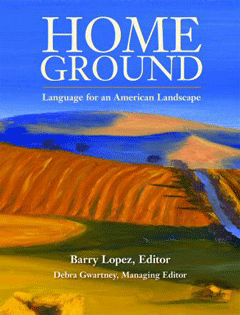The Language of Landscape
Air Date: Week of February 22, 2008

Home Ground: Language for an American Landscape, edited by Barry Lopez and Debra Gwartney. (Courtesy of Trinity University Press)
Living on Earth continues its series exploring features of the American landscape. Its based on the book Home Ground: Language for an American Landscape, edited by Barry Lopez and Debra Gwartney. In this installment, Barry Lopez explains the term “soil.”
Transcript
CURWOOD: Pesticides bound to the soil. Our land - our Home Ground - is soil.
[MUSIC: Daniel Lanois “O Marie (Homeground Theme)” from ‘Acadie’ (Daniellanois.com – 2005)]
CURWOOD: And soil - that humble, vital basis of all the greenery we depend on - is the subject of this excerpt from the book “Home Ground, Language for an American Landscape.” Nature writer Barry Lopez and fellow author Debra Gwartney gathered lyrical descriptions of landscape features in this book. Today Barry Lopez explains – soil.
LOPEZ: Soil. Erosion, volcanic eruption, earthquakes, floods, tectonic grinding, landslides, and other natural forces act continuously on the earth’s crustal rock, creating various types of debris—gravel deposits, mudflats and the tidal estuaries of creeks, cobble terraces, and beaches of black lava sand. When chemical agents, such as phosphorus and nitrogen, infuse this debris, and biological entities including microbes and earthworms work material into it organic enough to support plants, it becomes soil. A soil that is chemically or organically exhausted, that’s been pulverized or become deeply parched, that has been invaded by decomposing rock, or that’s been fowled by sewage or industrial pollution to the point where it no longer can support plant life, is called dirt.

"Home Ground: Language for an American Landscape," edited by Barry Lopez and Debra Gwartney.(Courtesy of Trinity University Press)
Links
Living on Earth wants to hear from you!
Living on Earth
62 Calef Highway, Suite 212
Lee, NH 03861
Telephone: 617-287-4121
E-mail: comments@loe.org
Newsletter [Click here]
Donate to Living on Earth!
Living on Earth is an independent media program and relies entirely on contributions from listeners and institutions supporting public service. Please donate now to preserve an independent environmental voice.
NewsletterLiving on Earth offers a weekly delivery of the show's rundown to your mailbox. Sign up for our newsletter today!
 Sailors For The Sea: Be the change you want to sea.
Sailors For The Sea: Be the change you want to sea.
 The Grantham Foundation for the Protection of the Environment: Committed to protecting and improving the health of the global environment.
The Grantham Foundation for the Protection of the Environment: Committed to protecting and improving the health of the global environment.
 Contribute to Living on Earth and receive, as our gift to you, an archival print of one of Mark Seth Lender's extraordinary wildlife photographs. Follow the link to see Mark's current collection of photographs.
Contribute to Living on Earth and receive, as our gift to you, an archival print of one of Mark Seth Lender's extraordinary wildlife photographs. Follow the link to see Mark's current collection of photographs.
 Buy a signed copy of Mark Seth Lender's book Smeagull the Seagull & support Living on Earth
Buy a signed copy of Mark Seth Lender's book Smeagull the Seagull & support Living on Earth

